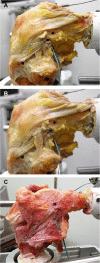The anterolateral ligament of the knee joint: a review of the anatomy, biomechanics, and anterolateral ligament surgery
- PMID: 32660576
- PMCID: PMC7219606
- DOI: 10.1186/s43019-019-0012-4
The anterolateral ligament of the knee joint: a review of the anatomy, biomechanics, and anterolateral ligament surgery
Abstract
Residual knee instability and low rates of return to previous sport are major concerns after anterior cruciate ligament (ACL) reconstruction. To improve outcomes, surgical methods, such as the anatomical single-bundle technique or the double-bundle technique, were developed. However, these reconstruction techniques failed to adequately overcome these problems, and, therefore, new potential answers continue to be of great interest. Based on recent anatomical and biomechanical studies emphasizing the role of the anterolateral ligament (ALL) in rotational stability, novel surgical methods including ALL reconstruction and anterolateral tenodesis have been introduced with the possibility of resolving residual instability after ACL reconstruction. However, there is still little consensus on many aspects of the ALL, including: several anatomical issues, appropriate indications for ALL surgery, and the optimal surgical method and graft choice for reconstruction surgery. Therefore, further studies are necessary to advance our knowledge of the ALL and its contribution to knee stability.
Keywords: ALL reconstruction; Anterior cruciate ligament; Anterolateral ligament; Anterolateral tenodesis; Knee instability.
Conflict of interest statement
The authors declare that they have no competing interests.
Figures


References
LinkOut - more resources
Full Text Sources

